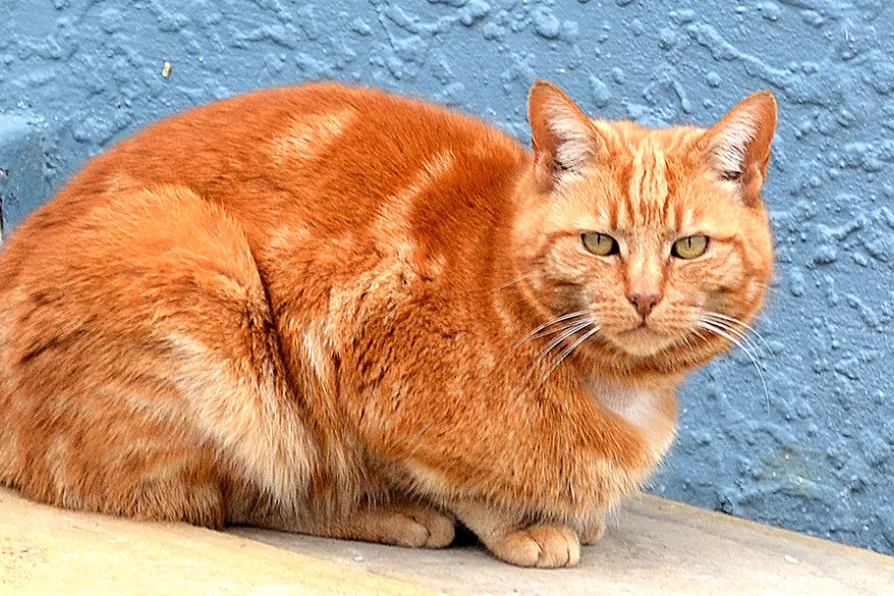KATE CLARK recalls an occasion when the president of the Scottish National Union of Mineworkers might just have saved a Chilean prisoner’s life

 LUCK OF THE DRAW: Two copies of the eumelanin inhibiting gene gives a completely orange cat
LUCK OF THE DRAW: Two copies of the eumelanin inhibiting gene gives a completely orange cat
THE DNA of domestic cats is bundled up into 38 chromosomes. Each chromosome is a long, tightly packed string of DNA that contains many different genes. The concept of a “gene” as a discrete unit of heredity dates back to before the discovery of DNA.
In the 20th century, it was realised that some regions of DNA are operated on by molecular machines in the cell, turning their encoded sequence into RNA and then into proteins, short-lived molecules that are involved in almost all cellular processes.
These DNA regions are what we now call genes. There is some nuance in this: for example, some regions of a gene are not turned into protein themselves and instead play a role in how exactly this happens.
Like humans, cats are “diploid” organisms, which have two copies of each chromosome, usually one from each parent, meaning two copies of every gene. Across the 19 pairs of chromosomes in a cat there are genes for every protein that the cat’s cells will produce over its lifetime, including proteins involved in processes such as digesting food or repairing wounds.
In most cases of fertilisation to produce a new cat, two sexual gametes — the sperm and egg — fuse into a single cell, with the resulting genome containing one chromosome from each.
(Conventionally these are called “maternal” and “paternal” chromosomes — we’ve previously written about the complicated relationship between biological sex and gender, and here we use “egg” and “sperm” instead.)
In a pair of chromosomes, the gene at the same location in the DNA on the chromosome from the egg might be different from that on the chromosome from the sperm. These variations of the same gene are known as alleles. Different alleles of a gene can contain slightly different DNA sequences, which can mean slightly different proteins that function differently.
How these different alleles on the chromosomes from the egg and sperm interact to produce “phenotypes” (observable traits) creates patterns in the inheritance of traits. However, most genetic stories are complex. Red hair in humans is a good example of this process.
In humans, there are many alleles of a gene on chromosome 16 that encodes a protein called ”melanocortin 1 receptor” (MC1R). Some variants of the MC1R protein cause a chain of interactions that lead pigment-producing cells called melanocytes to produce the darker brown or black pigment called “eumelanin.” Other versions of MC1R lead to much reduced or completely absent signalling for eumelanin, in which case the melanocyte reverts to producing the lighter, redder-coloured “phaeomelanin” pigment. These different variants are strongly, but not perfectly, associated with red hair.
Having even one copy of the eumelanin-associated MC1R allele usually leads to having dark hair. This is why red hair is called a “recessive trait,” because you usually need two copies of the allele that leads to phaeomelanin production to have the trait of red hair.
However, even an apparently simple trait like red hair is reliant on a web of molecular interactions that “bubble up” from the cellular level, and is only extremely rarely explainable by a single variant. In 2018 scientists announced that they had detected variation in a further eight genes that are related to red hair in humans, and there will undoubtedly be more.
Understanding how genetic traits are inherited boils down to understanding how the different combinations of pairs of alleles (an organism’s “genotype”) leads to differences in observable properties such as hair colour, or blood type, and so on (an organism’s “phenotype.”)
To return to cats, they share the XY sex determination system that humans have, inheriting an X chromosome from the egg and an X or a Y chromosome from the sperm.
Since all cats inherit X chromosomes, many genes on the X chromosome are not specifically related to sex determination, they’re activated in all cats. They may themselves encode proteins or they may interact with other genes on other chromosomes.
When a gene encodes the instructions for building a protein, the instructions are often followed on both the egg and sperm chromosomes, which may be different from each other. When the instructions in the DNA of a gene are acted upon this is referred to as gene expression.
Considering the sex chromosomes, genes on the X chromosome will have twice the level of gene expression in cats with two X chromosomes compared to cats with one X and one Y chromosome. However, over-expressing certain genes can be bad for a cat’s health.
To counter this problem, early on in the development of an embryo with two X chromosomes all of the cells randomly choose one of the two X chromosomes to inactivate. Within a cell, one X chromosome becomes stuck to the wall of the cell nucleus and is no longer able to be turned into proteins.
Crucially, once a cell has inactivated one X chromosome from the pair, that same chromosome is inactivated in all of the future generations of cells produced by the identical copies of that cell during the process of mitosis.
This process of X chromosome inactivation is responsible for an interesting phenomenon in the colour of tortoiseshell cats that is due to the interaction between the genes on two separate chromosomes.
In cats there are three alleles for the gene that encodes an enzyme responsible for signalling eumelanin (darker pigment) production, they are responsible for black, chocolate, or cinnamon coloured coats.
However, at the same time a gene on the X chromosome has two alleles: one that completely shuts off all eumelanin production and one that does not. In cats with one X chromosome this second gene determines whether any eumelanin is produced in any of their cells, so they are entirely red haired (no eumelanin at all) or entirely dark haired (and coat colour is determined by the first gene above).
In cats with two X chromosomes, coat colour depends on the alleles for shutting off eumelanin production in each of the two X chromosomes. Two copies of the eumelanin inhibiting gene gives a completely orange cat, two copies of the non-inhibiting gene gives a dark haired cat.
In cats with one inhibiting gene and one non-inhibiting gene, every cell would have randomly inactivated one of these genes in the process of X chromosome inactivation. The cells of the cat responsible for pigment production are therefore a patchwork of randomly selected X chromosomes, some of which produce dark pigment and some of which produce red pigment.
The observable effect of this is a beautiful tortoiseshell cat with its mosaic of dark and red fur. The random occurrences in cells early on in life lead to unique and fantastic patterns of the adult cat.
Yet even this is a somewhat simplified version of cat coat genetics. Further genes lead to white patches or different patterns in the fur. There is also hair length and thickness to consider. The interactions between many, many genes, as well as the environment that the cat grows up in, will each play roles of varying sizes in creating the final product.
Stories like red hair are used as introductory examples for a reason: because they are simplifications. In the early 2000s, there was optimism from some that all traits would be explained by genetics. But for most characteristics, most of the variation remains unexplained by single genetic variants. This “missing heritability” suggests that the simple stories connecting a single gene to a trait are crude simplifications.
Genes are sometimes misused as a shortcut explanation to determinism in humans when they are anything but. The genetic code provides the toolbox for the myriad possibilities in any person. What happens next is a complex mosaic of chance and association.

The distinction between domestic and military drones is more theoretical than practical, write ROX MIDDLETON, LIAM SHAW and MIRIAM GAUNTLETT

Nature's self-reconstruction is both intriguing and beneficial and as such merits human protection, write ROX MIDDLETON, LIAM SHAW and MIRIAM GAUNTLETT

A maverick’s self-inflicted snake bites could unlock breakthrough treatments – but they also reveal deeper tensions between noble scientific curiosity and cold corporate callousness, write ROX MIDDLETON, LIAM SHAW and MIRIAM GAUNTLETT
Science has always been mixed up with money and power, but as a decorative facade for megayachts, it risks leaving reality behind altogether, write ROX MIDDLETON, LIAM SHAW and MIRIAM GAUNTLETT














